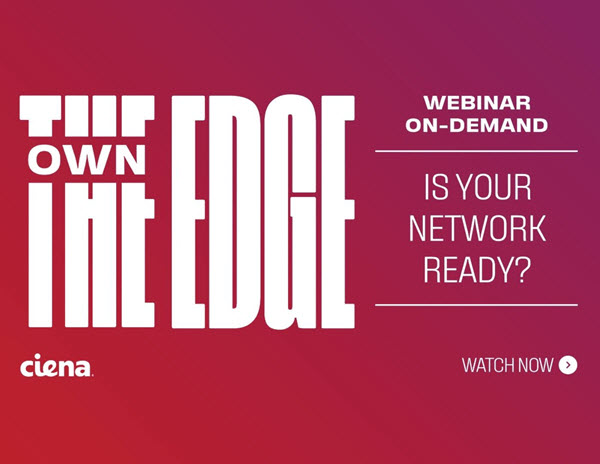Without an innovative new approach to xHaul, 5G monetization will be limited
The commercial necessity for an end-to-end approach to 5G was explored in a recent webinar that I had the pleasure of moderating. This was part of Ciena’s Next Generation Metro and Edge Series (Own the Edge: is your network ready?) and featured a lively discussion between executives from Ciena and Samsung Networks about the necessity for an innovative new approach to end-to-end network planning and management. Joining me for the session were:
- Brian Lavallée, Senior Director, Solutions Marketing, Ciena
- John Cassidy R&S Business Development
- Amresh Singh, Director of Partnerships for the Networks Business at Samsung Electronics America
Why is 5G xHaul different?
All the participants agreed that xHaul (fronthaul, midhaul, and backhaul) is a critical element of the performance and commercial success of a 5G network. The 5G business model will increasingly rely on mobile and wholesale network operators enabling advanced, high-value services for enterprises and consumers, which will make unprecedented demands on the network to deliver optimal quality of experience. Those demands for capacity, reliability, flexibility, and ubiquitous availability will only be fulfilled if the network is optimised from end to end, with no bottlenecks across the wireless and wireline domains.
5G must be dense, ubiquitous, and ultra-reliable, which means huge numbers of cell sites and edge nodes that will also need very large numbers of high-quality fronthaul, midhaul, and backhaul transport links.
Traditionally, backhaul investments were made when the capacity of a new radio access network (RAN) surpassed that of the connections back to the core resulting in a degraded user experience. In 5G, capacity demands are expected to be 10 times higher than in 4G/LTE, and at the same time, user expectations of a fast, reliable experience are rising all the time as they increasingly use the cellular network for advanced immersive experiences, or for business-critical processes in the enterprise. This means xHaul must be planned and implemented proactively.
This is not just about supporting applications that use large amounts of data, such as extended reality. Behind the headlines about the metaverse, or human/digital fusion in the enterprise, lie real movements away from the world of siloed applications, in which every user connects individually via central clouds, to a world of limitless and dynamic interconnections between millions of users, devices, sensors, and services.
This massive interconnection can only be supported by software-defined infrastructure from end to end; and services will be enabled by ubiquitous data analytics and AI. This transformed network will deliver new revenues because it can be optimised for so many different applications, user experiences, and behaviours.
The cloud-based network comes with new xHaul challenges
In turn, this requires a new approach to the network’s entire architecture, with profound effects on how xHaul is planned and managed. 5G will be the first fully cloud-based mobile network, which will give it the enormous scalability and agility necessary to support many experiences and services that have not been possible before.
This is driving adoption of cellular networks that are virtualised, disaggregated, and open, all of which will maximise the flexibility to focus network resources wherever they are needed by a particular application, at a particular time. That, in turn, enhances resource- and cost-efficiency as well as commercial agility.
 This opening up of the RAN is what drives adoption of a more complex transport architecture than backhaul alone. Increasingly, and especially as they migrate to 5G Standalone, operators are adopting disaggregated networks in which radio units are separated from basebands, and basebands may be split into centralised units and distributed units. In turn, those basebands may be virtualised on cloud infrastructure. The interfaces between the various elements are known as fronthaul and midhaul, and these have extremely demanding requirements in terms of capacity and latency, to support the near-real-time processes of Layer 1 baseband processing, and the very precise timing and synchronization needed to enable the optimal 5G experience.
This opening up of the RAN is what drives adoption of a more complex transport architecture than backhaul alone. Increasingly, and especially as they migrate to 5G Standalone, operators are adopting disaggregated networks in which radio units are separated from basebands, and basebands may be split into centralised units and distributed units. In turn, those basebands may be virtualised on cloud infrastructure. The interfaces between the various elements are known as fronthaul and midhaul, and these have extremely demanding requirements in terms of capacity and latency, to support the near-real-time processes of Layer 1 baseband processing, and the very precise timing and synchronization needed to enable the optimal 5G experience.
There are many ways to distribute RAN functions between the different elements, and that flexibility will be essential to support the largest number of applications with different requirements. But that also means xHaul must be equally flexible and software-defined so the network resources can be adjusted automatically to cope with changes in service requirements. xHaul networks must also converge existing 4G and future 5G network traffic onto common infrastructure for improved economies of scale.
Open networks are critical to commercial success
In an Open RAN environment, those interfaces are based on universally agreed specifications so that multivendor networks are achievable. Samsung Networks has been a prominent supporter of the O-RAN Alliance and offers a fully virtualised and open RAN platform.
In such a platform, common xHaul links enable operators to adopt solutions from different suppliers in the RAN, core and transport, and also within the RAN itself. This is leading to innovative partnerships in the 5G world, with vendors with different specialisations able, for the first time, to integrate their offerings in a standards-based way.
Ciena’s Lavallée believes that this open approach will address many of the acknowledged challenges of moving from an integrated, single-vendor RAN to an open, multivendor, end-to-end 5G platform. He recognises operators’ concerns about integration complexity or management overhead but argues that an open platform supports pre-integration and pre-testing that accesses a wide pool of innovation, focused on addressing challenges and simplifying the network architecture and deployment.
Ciena and Samsung Networks have cooperated to develop an innovative end-to-end solution that allows operators to take advantage of each vendors’ significant expertise in their respective wireless and wireline domains. Given the generally available end-to-end solution is pre-integrated and pre-tested by Ciena and Samsung, operators can easily deploy a best-of-breed, multi-vendor network in a rapid and risk-free manner.
Industry cooperation on open, software-defined architectures is already progressing towards a transport network that is flat and simplified, with convergence between the routing, switching, and optical layers. Not just xHaul, but the whole transport network, will be planned end-to-end to support key 5G use cases such as dynamic network slicing, in which an optimised set of wireless and wireline network resources are virtually isolated for the use of particular service or customer.
Slicing is a key goal for many operators as it will enable a very wide range of different services while maintaining the economies of scale of a single, unified network. Slicing is by its nature, end-to-end, and perhaps the best example of why the webinar panel was so united in agreeing by the conclusion of the debate. Transport architectures in the 5G era, we all agreed, must support ultra-dense and multi-layered networks. To do this with maximum efficiency, they must be de-siloed, automated, software-defined, and open. Only then will they deliver the maximum opportunities for 5G monetisation.








